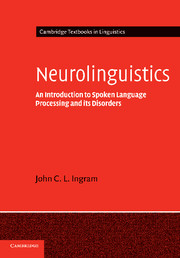Book contents
- Frontmatter
- Contents
- List of figures
- List of tables
- Preface and acknowledgements
- Note on the text
- Part I Foundational concepts and issues
- 1 Introduction and overview
- 2 Aspects of linguistic competence
- 3 The neuroanatomy of language
- 4 On modularity and method
- Part II Speech perception and auditory processing
- Part III Lexical semantics
- Part IV Sentence comprehension
- Part V Discourse: language comprehension in context
- Glossary
- References
- Index
3 - The neuroanatomy of language
Published online by Cambridge University Press: 26 January 2010
- Frontmatter
- Contents
- List of figures
- List of tables
- Preface and acknowledgements
- Note on the text
- Part I Foundational concepts and issues
- 1 Introduction and overview
- 2 Aspects of linguistic competence
- 3 The neuroanatomy of language
- 4 On modularity and method
- Part II Speech perception and auditory processing
- Part III Lexical semantics
- Part IV Sentence comprehension
- Part V Discourse: language comprehension in context
- Glossary
- References
- Index
Summary
Introduction
This chapter seeks to ‘let the brain do the talking’ about how it organizes itself for language. Our approach is consistent with the co-evolution hypothesis of chapter 1, and a long-established principle that biological systems evolve new capabilities by reconfiguring or adding an emergent layer of control upon systems already evolved to serve more basic and often quite unrelated biological functions. Thus, three functionally distinct systems for breathing, coughing (expelling foreign bodies from the windpipe) and deglutition (chewing and swallowing food) were harnessed into a single co-ordinated system for controlling the airstream, voicing and articulation mechanisms for the emergent function of speech production. Similarly, human language capabilities most likely emerged as a reconfiguration of pre-linguistic (or pre-symbolic) systems of perceptual representation, memory and response planning, which in turn evolved from more primitive sensory-motor (stimulus–response) control systems.
Of course, the brain cannot speak for itself, so we are obliged to adopt the next best course and view our subject matter from the perspective of those whose principal concern was/is the understanding of the brain and who were bold (or foolish) enough to extend their inquiries to the question of how the brain represents language. We begin by reviewing the classical clinical findings from the history of aphasiology to acquaint the reader with the major symptom clusters of speech and language disorder and to provide a first-approximation model of how language may be represented in the brain.
- Type
- Chapter
- Information
- NeurolinguisticsAn Introduction to Spoken Language Processing and its Disorders, pp. 40 - 65Publisher: Cambridge University PressPrint publication year: 2007

